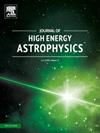The origin of very-high-energy gamma-rays from GRB 221009A: Implications for reverse shock proton synchrotron emission
IF 10.2
4区 物理与天体物理
Q1 ASTRONOMY & ASTROPHYSICS
引用次数: 0
Abstract
Recently, GRB 221009A, known as the brightest of all time (BOAT) GRB, has been observed across an astounding range of ∼18 orders of magnitude in energy, spanning from radio to very-high-energy (VHE) bands. Notably, the Large High Altitude Air Shower Observatory (LHAASO) recorded over 60000 photons with energies exceeding , including the first-ever detection of photons above . However, explaining the observed energy flux evolution in the VHE band alongside late-time multi-wavelength data poses a significant challenge. Our approach involves a two-component structured jet model, consisting of a narrow core dominated by magnetic energy and a wide jet component dominated by matter. We show that the combination of the forward shock electron synchrotron self-Compton emission from the two-component structured jet and reverse shock proton synchrotron emission from the wide jet could account for both the energy flux and spectral evolution in the VHE band, and the early TeV lightcurve may be influenced by prompt photons which could explain the initial steep rising phase. We notice the arrival time of the highest energy photon ∼ 13 TeV detected by LHAASO, especially a minor flare and spectral hardening occurring about ∼ 500 - 800 seconds after the trigger, is consistent with the emergence of the reverse shock proton synchrotron emission. These findings imply that the GRB reverse shock may serve as a potential accelerator of ultra-high-energy cosmic rays, a hypothesis that could be tested through future multimessenger observations.
求助全文
约1分钟内获得全文
求助全文
来源期刊

Journal of High Energy Astrophysics
Earth and Planetary Sciences-Space and Planetary Science
CiteScore
9.70
自引率
5.30%
发文量
38
审稿时长
65 days
期刊介绍:
The journal welcomes manuscripts on theoretical models, simulations, and observations of highly energetic astrophysical objects both in our Galaxy and beyond. Among those, black holes at all scales, neutron stars, pulsars and their nebula, binaries, novae and supernovae, their remnants, active galaxies, and clusters are just a few examples. The journal will consider research across the whole electromagnetic spectrum, as well as research using various messengers, such as gravitational waves or neutrinos. Effects of high-energy phenomena on cosmology and star-formation, results from dedicated surveys expanding the knowledge of extreme environments, and astrophysical implications of dark matter are also welcomed topics.
 求助内容:
求助内容: 应助结果提醒方式:
应助结果提醒方式:


